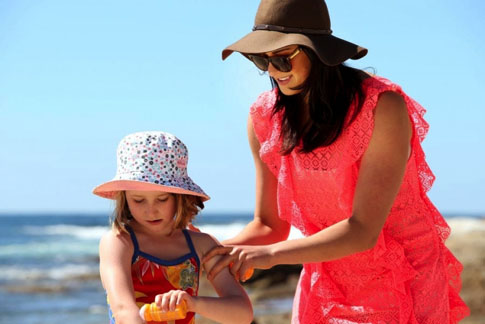The Perfect Summer Tan: Is it Worth it?
May 14, 2015, 11:54 pm
The time for fun in the sun has finally arrived! You do your best to protect your family in the summer with a surplus of bug sprays, helmets, and water wings, so why not protect them from the sun?

Skin cancer, also known as melanoma, can develop from prolonged sun exposure or indoor tanning beds. Keep your family safe this summer with these skin cancer facts and prevention tips:
Melanoma Facts:
- Melanoma rates are increasing faster than nearly all other cancers.
- Melanoma is a relatively easy disease to prevent.
- Most melanomas are easy to stop if caught soon enough — all it takes is a yearly skin exam.
- Melanoma kills one person every hour.
- Melanoma is the most common cancer among women aged 25-32.
- As many as 10,000 people a year die from melanoma.
Tanning Facts:
- The increased risk of melanoma associated with early tanning bed use is 59% for people whose first exposure to artificial UV rays in a tanning bed occurred before age 35 years and that risk increased with the number of tanning bed sessions per year.
- It is not safe to tan in the sun or in a tanning booth.
- The more you tan and the younger you start tanning, the more likely it is that you will get melanoma.
- Using a tanning bed for 20 minutes is equivalent to spending one to three hours a day at the beach with no sun protection at all.
- Tanning beds put out three to six times the amount of radiation given off by the sun.
- For most people, 5-10 minutes of unprotected sun 2-3 times a week is enough to help your skin make Vitamin D, which is essential for your health. Getting more sun won’t increase your Vitamin D level, but it will increase your risk of skin cancer. Vitamin D also comes from orange juice, milk, fish, and supplements.
Sun Safety:
- How much sunscreen do I need to use?
- One ounce if using lotion (enough to fill a shot glass).
- Be liberal with application.
- What is the right way to apply sunscreen?
- Apply sunscreen 15-30 minutes before going outside.
- If using a spray, avoid the face and spray enough to be evenly coated.
- Areas that are often missed include the scalp- especially the area where you part your hair- and the tops and backs of the ears, feet, and neck.
- Does a tan protect you from getting sunburn?
- People who have a tendency to tan instead of burn have a little bit of natural protection, but it doesn’t matter how much melanin a person has as anyone can get skin cancer.
- What SPF in sunscreen is the most effective?
- For the majority of people, SPF 15 is fine, but people that have fair skin or other sensitive skin conditions should consider SPF 30 or higher.
- The higher the SPF, the smaller the increased benefit. Contrary to what you might think, SPF 30 isn't twice as strong as SPF 15. While SPF 15 filters out 93% of UVB, SPF 30 filters out 97%, only a slight improvement.
Sources:
Griffin, R. Morgan. “What’s the Best Sunscreen?” 2005-2015 WebMd. (http://www.webmd.com/beauty/sun/whats-best-sunscreen
Miller, Kelli. “Sun Safety: Expert Q&A”. 2005-2015 WebMd. (http://www.webmd.com/beauty/sun/sun-safety-expert-q-and-a)
Melanoma Foundation New England 2012. (http://mfne.org/learn-about-melanoma/tanning-and-melanoma-facts/)
